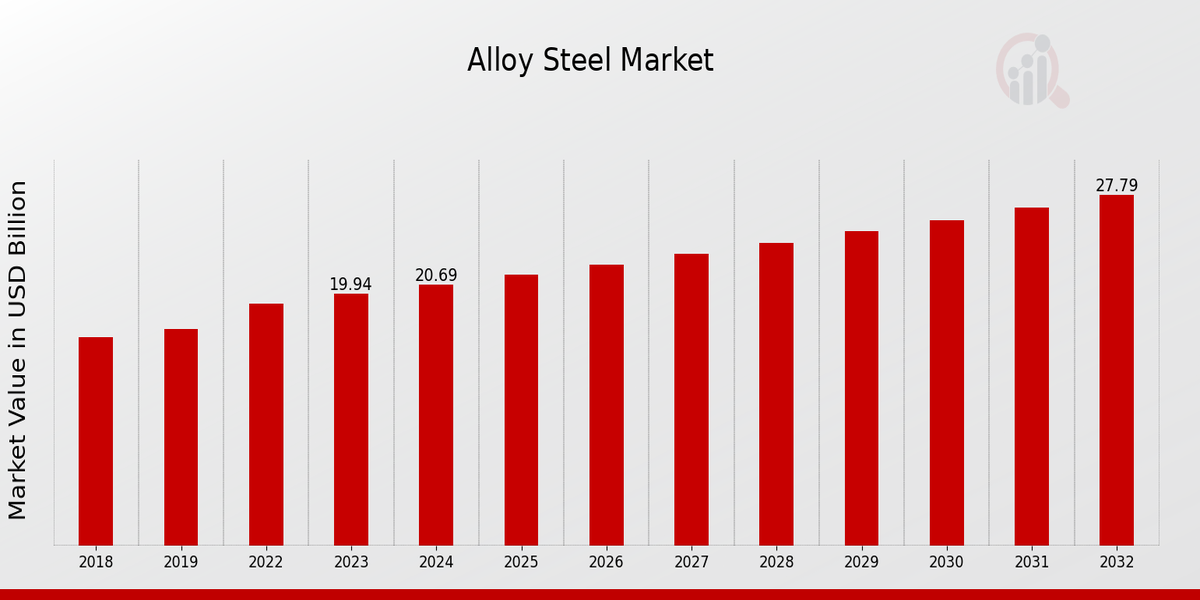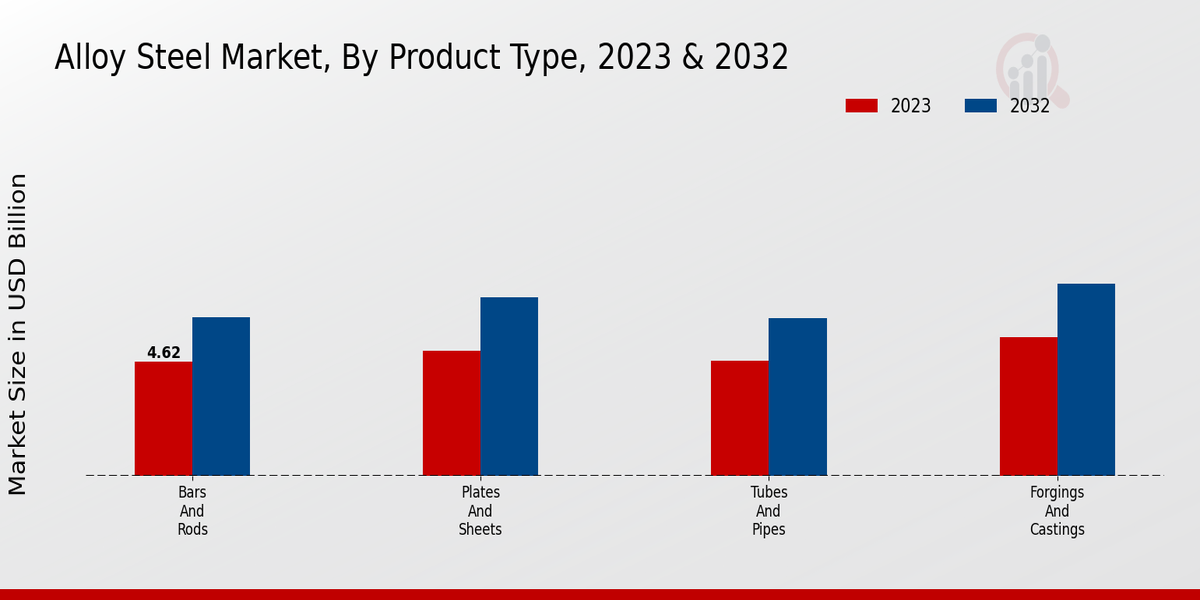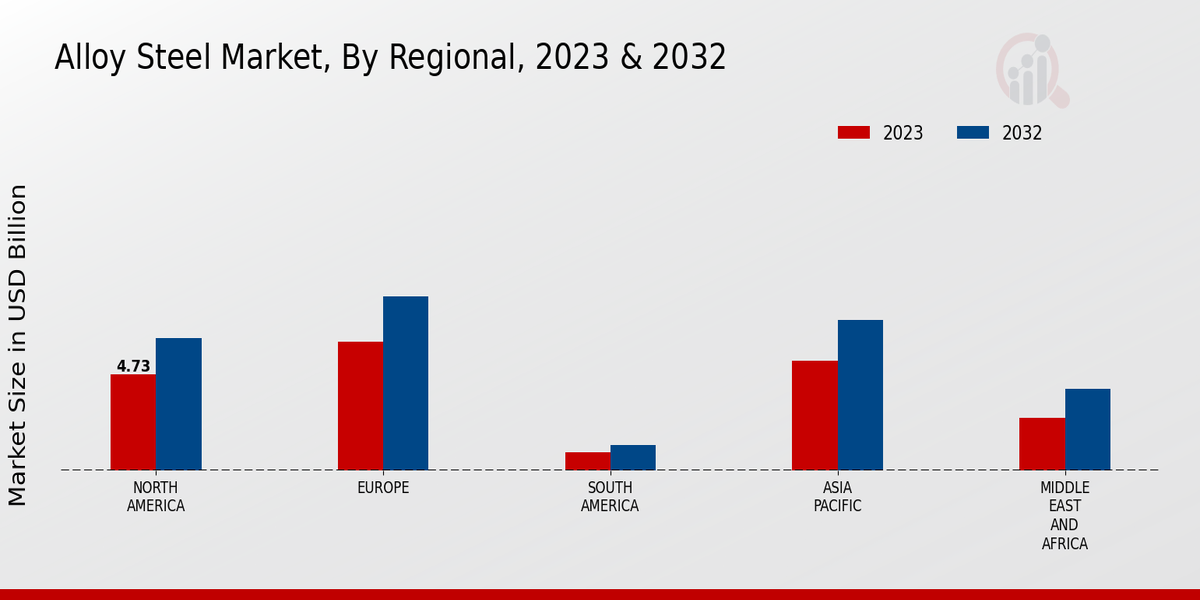Global Alloy Steel Market Overview
Alloy Steel Market Size was estimated at 21.46 (USD Billion) in 2024.The Alloy Steel Industry is expected to grow from 22.27 (USD Billion) in 2025 to 31.05 (USD Billion) by 2034. The Alloy Steel Market CAGR (growth rate) is expected to be around 3.76% during the forecast period (2025 - 2034).

Source Primary Research, Secondary Research, MRFR Database and Analyst Review
Key Alloy Steel Market Trends Highlighted
The various factors that drive the market for alloy steel include increased demand from different sectors such as automotive, construction and energy. Growth in infrastructure development and urbanization, as well as investment in manufacturing and fabrication, is supporting its expansion. Market growth is likewise driven by the increasing use of alloy steel in lightweight vehicles and eco-friendly appliances. The alloy steel market has opportunities to grow by exploring new alloys and technologies related to high-strength, lightweight materials. Similarly, the growing adoption of advanced production methods like additive manufacturing or automation has also created opportunities for expanding into other markets. During the recent period, demand for alloy steel has grown significantly due to wind turbines and solar panels, among others, which are renewable energy applications since the trend towards sustainability is driving it. These trends will continue shaping the market over the next few years.
Alloy Steel Market Drivers
Rising Demand from Automotive Industry
The automotive industry is a major consumer of alloy steel, particularly in the production of high-strength and lightweight components. The increasing demand for vehicles, especially in emerging markets, is driving the growth of the alloy steel market. Alloy steels are used in various automotive applications, including engine components, transmission systems, suspension systems, and body panels. The need for lightweight and fuel-efficient vehicles is further boosting the demand for alloy steels in the automotive sector.
Growing Infrastructure Development
Alloy steels are extensively used in the construction industry for various applications, including bridges, buildings, and infrastructure projects. The increasing urbanization and infrastructure development worldwide are contributing to the growth of the Alloy Steel Market Industry. Alloy steels offer high strength, durability, and corrosion resistance, making them ideal for use in demanding construction applications. The rising demand for infrastructure development in emerging economies is expected to drive the growth of the alloy steel market in the coming years.
Technological Advancements in Energy Sector
Alloy steels are very important in the energy field, especially when it comes to oil and gas production and transportation. The demand for alloy steels that have improved properties has been increased through the advent of new technology, such as deep-water drilling and unconventional oil and gas extraction. High strength, corrosion resistance, and durability are some of the attributes needed by these metals that go into the construction of pipelines and drilling equipment, among others.
The demand for energy is increasing rapidly across the globe and there is a great need for efficient and reliable energy infrastructure; this will continue to be a growth driver in the alloy steel market for the energy sector.
Alloy Steel Market Segment Insights
Alloy Steel Market Product Type Insights
The alloy steel market is segmented by product type into bars and rods, plates and sheets, tubes and pipes, and forgings and castings. The plates and sheets segment is expected to be the second-largest segment in 2023 and is projected to grow at a CAGR of 3.68% from 2023 to 2034. The tubes and pipes segment is expected to be the third-largest segment in 2023 and is projected to grow at a CAGR of 3.59% from 2023 to 2034. The forgings and castings segment is expected to be the smallest segment in 2023 and is projected to grow at a CAGR of 3.43% from 2023 to 2034.The growth of the alloy steel market is attributed to the increasing demand from various end-use industries, such as automotive, construction, and energy. The automotive industry is the largest end-use industry for alloy steel and is expected to continue to drive demand for alloy steel in the coming years. The construction industry is also a major end-use industry for alloy steel and is expected to grow at a steady pace in the coming years. The energy industry is also a major end-use industry for alloy steel and is expected to grow at a moderate pace in the coming years.Alloy steel is a high-strength steel that is alloyed with other elements, such as chromium, nickel, and molybdenum. Alloy steel is stronger and more durable than carbon steel and is used in a wide range of applications. Alloy steel is used in automotive applications, such as gears, shafts, and bearings. Alloy steel is also used in construction applications, such as bridges, buildings, and towers. Alloy steel is also used in energy applications, such as pipelines, valves, and pumps. The alloy steel market is a competitive market with a number of major players.The major players in the alloy steel market include ArcelorMittal, Nippon Steel Sumitomo Metal Corporation, POSCO, and ThyssenKrupp. These companies are investing in research and development to develop new and innovative alloy steel products. They are also expanding their production capacity to meet the growing demand for alloy steel.
Source Primary Research, Secondary Research, MRFR Database and Analyst Review
Alloy Steel Market Strength Insights
The alloy steel market is segmented based on strength into low-strength, medium-strength, high-strength, and ultra-high-strength alloy steel. Among these segments, the high-strength alloy steel segment is expected to hold the largest share of the market in 2023, accounting for around 40% of the alloy steel market revenue. The growth of this segment is attributed to the increasing demand for high-strength steel in various industries, including automotive, construction, and engineering. The low-strength alloy steel segment is expected to witness a steady growth rate during the forecast period, owing to its wide applications in industries such as construction and consumer goods.The medium-strength alloy steel segment is expected to hold a significant share of the market, driven by its use in automotive and industrial applications. The ultra-high-strength alloy steel segment is expected to witness a significant growth rate during the forecast period, owing to its increasing use in aerospace and defense applications.
Alloy Steel Market Alloying Elements Insights
The Alloying Elements segment is a crucial aspect of the Alloy Steel Market, influencing its properties and applications. Nickel, Chromium, Molybdenum, Vanadium, and Tungsten are key alloying elements used in alloy steel production. Nickel enhances strength, toughness, and corrosion resistance, making it suitable for applications in marine and chemical industries. Chromium improves hardness, wear resistance, and oxidation resistance, leading to its use in automotive and cutting tools. Molybdenum increases strength, hardenability, and resistance to softening at high temperatures, making it ideal for high-performance applications like aerospace and energy.Vanadium refines grain structure, improves toughness, and enhances wear resistance, finding applications in construction and transportation. Tungsten provides exceptional hardness and wear resistance, making it essential for cutting tools and armor. In 2023, the Alloy Steel Market revenue from the Alloying Elements segment is estimated to reach USD 12.4 billion, with a projected growth to USD 16.7 billion by 2034, exhibiting a CAGR of 3.7%. The increasing demand for alloy steel in various industries, including automotive, construction, and energy, is driving the growth of this segment.
Alloy Steel Market End-Use Industry Insights
The end-use industry segment plays a crucial role in shaping the dynamics of the Alloy Steel Market. Among the key end-use industries, Automotive, Construction, Energy, Aerospace, and Machinery stand out as major drivers of market growth. Automotive Alloy steel finds extensive use in the production of automotive components, including gears, shafts, and suspension systems, due to its exceptional strength and durability. The rising demand for lightweight and fuel-efficient vehicles is expected to drive the growth of the automotive segment in the coming years.Construction Alloy steel's strength and resistance to corrosion make it an ideal material for various construction applications, such as bridges, buildings, and infrastructure projects. The increasing urbanization and infrastructure development worldwide are anticipated to boost the demand for alloy steel in the construction industry. Energy Alloy steel is widely utilized in the energy sector, particularly in the construction of pipelines, drilling equipment, and power generation plants. The growing demand for energy and the transition towards renewable energy sources are expected to create new opportunities for the alloy steel market in the energy industry.Aerospace Due to its high strength-to-weight ratio and ability to withstand extreme temperatures, alloy steel is essential in the aerospace industry. It is used in the fabrication of aircraft components, engines, and landing gear. The increasing demand for air travel and the development of new aircraft technologies are anticipated to drive the growth of the alloy steel market in the aerospace industry. Machinery Alloy steel is employed in the manufacturing of heavy machinery, such as mining equipment, construction machinery, and agricultural machinery.The growing demand for machinery in various industries is expected to contribute to the growth of the alloy steel market in the machinery segment.
Alloy Steel Market Regional Insights
The regional segmentation of the Alloy Steel Market offers valuable insights into the market's geographical distribution and growth potential. North America is anticipated to hold a significant market share in 2024, driven by the region's robust automotive and construction industries. Europe is another key region in the Alloy Steel Market, with its strong manufacturing base and increasing demand from various industries. The Asia-Pacific (APAC) region is expected to witness substantial growth in the coming years, fueled by the rapidly developing economies of China and India. South America and the Middle East and Africa (MEA) regions are also expected to contribute to the overall growth of the Alloy Steel Market.
Source Primary Research, Secondary Research, MRFR Database and Analyst Review
Alloy Steel Market Key Players And Competitive Insights
Major players in the Alloy Steel Market industry are consistently striving to develop and introduce advanced products to cater to the evolving demands of end-use industries. Strategic collaborations, mergers, and acquisitions are common practices among leading Alloy Steel Market players to expand their presence and strengthen their market position. The competitive landscape is characterized by intense competition, with companies investing heavily in research and development to gain a competitive edge. Continuous product innovation and technological advancements are crucial factors driving the Alloy Steel Market development.A prominent competitor in the Alloy Steel Market is ArcelorMittal, a steel and mining company headquartered in Luxembourg. The company boasts a diverse product portfolio, including a wide range of alloy steel grades tailored to specific industry requirements. ArcelorMittal has a strong focus on sustainability and innovation, continuously seeking ways to reduce its environmental impact and enhance the performance of its products. With a presence and a commitment to customer satisfaction, the company has established a strong reputation in the Alloy Steel Market.Another key player in the Alloy Steel Market is Nippon Steel Corporation, a Japanese steel manufacturer. The company is known for its high-quality alloy steels, particularly in the automotive and energy sectors. Nippon Steel Corporation has a robust research and development program, investing heavily in advanced technologies to develop innovative solutions for its customers. The company's commitment to quality and customer-centric approach has earned it a loyal customer base in both domestic and international markets. Nippon Steel Corporation is actively involved in strategic partnerships and collaborations to expand its reach and strengthen its position in the Alloy Steel Market.
Key Companies in the Alloy Steel Market Include
- Kobe Steel
- SAIL
- Outokumpu
- Timken
- Thyssenkrupp
- Baoshan Iron Steel
- HBIS Group
- Carpenter Technology
- POSCO
- JFE Steel
- Hyundai Steel
- Aperam
- Nippon Steel
- ArcelorMittal
- Tata Steel
Alloy Steel Market Industry Developments
Rising demand from the automotive, construction, and energy sectors is driving market growth. The automotive industry is a major consumer of alloy steel, used in components such as gears, shafts, and bearings. Increasing vehicle production, particularly in emerging economies, is expected to boost alloy steel demand. The construction sector also utilizes alloy steel for structural applications, such as bridges and buildings. Additionally, the growing adoption of renewable energy sources, such as wind and solar, is creating demand for alloy steel in wind turbine components and solar panel frames. Regional markets, such as Asia-Pacific and North America, are expected to witness significant growth due to rapid industrialization and infrastructure development.
Alloy Steel Market Segmentation Insights
Alloy Steel Market Product Type Outlook
- Bars and Rods
- Plates and Sheets
- Tubes and Pipes
- Forgings and Castings
Alloy Steel Market Strength Outlook
- Low-Strength Alloy Steel
- Medium-Strength Alloy Steel
- High-Strength Alloy Steel
- Ultra-High-Strength Alloy Steel
Alloy Steel Market Alloying Elements Outlook
- Nickel
- Chromium
- Molybdenum
- Vanadium
- Tungsten
Alloy Steel Market End-Use Industry Outlook
- Automotive
- Construction
- Energy
- Aerospace
- Machinery
Alloy Steel Market Regional Outlook
- North America
- Europe
- South America
- Asia Pacific
- Middle East and Africa
Alloy Steel Market Report Scope
| Report Attribute/Metric |
Details |
| Market Size 2024 |
21.46 (USD Billion) |
| Market Size 2025 |
22.27 (USD Billion) |
| Market Size 2034 |
31.05 (USD Billion) |
| Compound Annual Growth Rate (CAGR) |
3.76% (2025 - 2034) |
| Report Coverage |
Revenue Forecast, Competitive Landscape, Growth Factors, and Trends |
| Base Year |
2024 |
| Market Forecast Period |
2025 - 2034 |
| Historical Data |
2020 - 2024 |
| Market Forecast Units |
USD Billion |
| Key Companies Profiled |
Kobe Steel, SAIL, Outokumpu, Timken, Thyssenkrupp, Baoshan Iron Steel, HBIS Group, Carpenter Technology, POSCO, JFE Steel, Hyundai Steel, Aperam, Nippon Steel, ArcelorMittal, Tata Steel |
| Segments Covered |
Product Type, Strength, Alloying Elements, End-Use Industry, Regional |
| Key Market Opportunities |
Rising demand from the automotive industry Increasing infrastructure development Growth in the energy and power generation sector Government initiatives and regulations Technological advancements |
| Key Market Dynamics |
Increasing demand for lightweight and high-strength materials Growth in the automotive and aerospace industries Government regulations on emissions and fuel efficiency Availability of cost-effective production processes Technological advancements in alloy development |
| Countries Covered |
North America, Europe, APAC, South America, MEA |
Frequently Asked Questions (FAQ) :
The Alloy Steel Market size was valued at USD 22.27 billion in 2025 and is projected to reach USD 31.05 billion by 2034, exhibiting a CAGR of 3.76% during the forecast period.
North America held the largest market share in 2024 and is expected to maintain its dominance throughout the forecast period. The growth in this region can be attributed to the increasing demand from automotive, construction, and manufacturing industries.
Alloy Steel finds applications in various industries, including automotive, construction, energy, and manufacturing. In the automotive industry, it is used in the production of crankshafts, gears, and other components. In construction, it is employed in the fabrication of bridges, buildings, and other structures. Additionally, it is utilized in the energy sector for the production of pipelines, valves, and other components.
Some of the key players in the Alloy Steel Market include ArcelorMittal, Baoshan Iron Steel, Nippon Steel Sumitomo Metal Corporation, POSCO, and ThyssenKrupp.
The growth of the Alloy Steel Market is primarily driven by the increasing demand from the automotive and construction industries. The rising demand for lightweight and fuel-efficient vehicles is propelling the demand for Alloy Steel in the automotive sector. Additionally, the growing infrastructure development activities worldwide are contributing to the demand for Alloy Steel in the construction industry.
The Alloy Steel Market faces challenges such as the volatility in raw material prices and the intense competition from alternative materials. The fluctuating prices of iron ore and other raw materials can impact the profitability of Alloy Steel producers. Additionally, the increasing adoption of lightweight materials, such as aluminum and composites, in automotive and other industries poses a challenge to the growth of the Alloy Steel Market.
The Alloy Steel Market presents opportunities for growth in emerging economies, where infrastructure development activities are expected to increase in the coming years. Additionally, the development of new alloys with improved properties, such as higher strength and corrosion resistance, can create new opportunities for market growth.
One of the key trends in the Alloy Steel Market is the development of advanced high-strength steels (AHSS). AHSS is designed to provide higher strength and toughness while maintaining formability, making them suitable for applications in the automotive industry. Additionally, there is a growing trend towards the use of recycled steel in the production of Alloy Steel, which is driven by sustainability concerns.
The COVID-19 pandemic had a significant impact on the Alloy Steel Market, leading to a decline in demand from key end-use industries such as automotive and construction. However, as the economy recovers from the pandemic, the demand for Alloy Steel is expected to rebound, driven by the resumption of infrastructure projects and the recovery of the automotive industry.
The Alloy Steel Market is expected to witness steady growth in the coming years, driven by the increasing demand from emerging economies and the development of new applications in various industries. The growing adoption of advanced technologies, such as artificial intelligence (AI) and the Internet of Things (IoT), is also expected to create new opportunities for growth in the Alloy Steel Market.

















